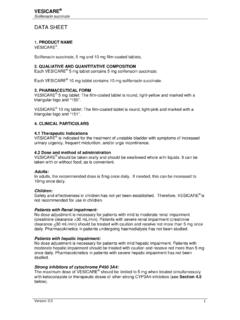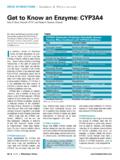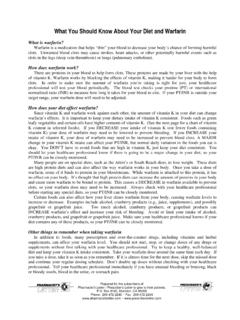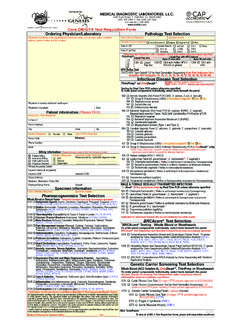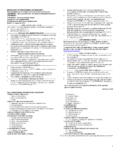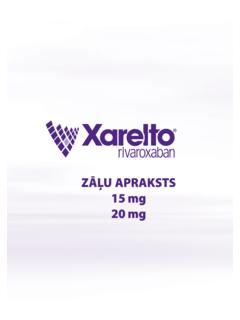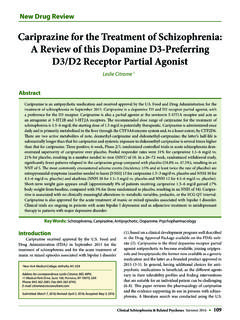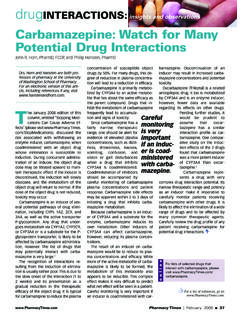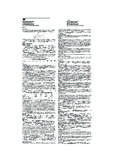Transcription of ANNEX I SUMMARY OF PRODUCT CHARACTERISTICS
1 ANNEX ISUMMARY OF PRODUCT OF THE MEDICINAL PRODUCTIRESSA250 mg film-coated AND QUANTITATIVE COMPOSITIONEach tablet contains 250mg of with known effect: Each tablet contains of lactose (as monohydrate)For the full list of excipients, see FORMFilm-coated tablets (tablet).Tablets are brown, round, biconvex, impressed with IRESSA250 on one side and plain on the indicationsIRESSAis indicated as monotherapy for the treatment of adult patients with locally advanced or metastatic non-small cell lung cancer (NSCLC) with activating mutations of EGFR-TK (see ). and method of administrationTreatment with IRESSA should be initiated and supervised by a physician experienced in the use of anticancer recommended posology of IRESSAis one 250mg tablet once a day. If a dose is missed, it should be taken as soon as the patient remembers. If it is less than 12hours to the next dose, the patient should not take the missed dose.
2 Patients should not take a double dose (two doses at the same time) to make up for a forgotten populationThe safety and efficacy of IRESSAin children and adolescents aged less than 18years have not been established. There is no relevant use of gefitinib in the paediatric population in the indication of impairmentPatients with moderate to severe hepatic impairment (Child-Pugh B or C) due to cirrhosis have increased plasma concentrations of gefitinib. These patients should be closely monitored for adverse events. Plasma concentrations were not increased in patients with elevated aspartate transaminase (AST), alkaline phosphatase or bilirubin due to liver metastases (see ).Renal impairmentNo dose adjustment is required in patients with impaired renal function at creatinine clearance > 20 ml/min. Only limited data are available in patients with creatinine clearance 20 ml/min and caution is advised in these patients (see ).
3 Elderly No dose adjustment is required on the basis of patient age (see ).CYP2D6 poor metabolisersNo specific dose adjustment is recommended in patients with known CYP2D6 poor metaboliser genotype, but these patients should be closely monitored for adverse events (see ).Dose adjustment due to toxicityPatients with poorly tolerated diarrhoea or skinadverse reactions may be successfully managed by providing a brief (up to 14days) therapy interruption followed by reinstatement of the 250mg dose (see ). For patients unable to tolerate treatment after a therapy interruption, gefitinibshould be discontinued and an alternative treatment should be of administrationThe tablet may be taken orally with or without food, at about the same time each day. The tablet can be swallowed whole with some water or if dosing of whole tablets is not possible, tablets may be administered as a dispersion in water (non-carbonated).
4 No other liquids should be used. Without crushing it, the tablet should be dropped in half a glass of drinking water. The glass should be swirled occasionally, until the tablet is dispersed (this may take up to 20minutes). The dispersion should be drunk immediately after dispersion is complete ( within 60minutes). The glass should be rinsed with half a glass of water, which should also be drunk. The dispersioncan also be administered through a naso-gastric or gastrostomy to the active substance or to any of the excipients listed in (see ). warnings and precautions for useWhen considering the use of IRESSAas a treatment for locally advanced or metastatic NSCLC, it is important that EGFR mutation assessment of the tumour tissue is attempted for all patients. If a tumour sample is not evaluable, then circulating tumour DNA (ctDNA) obtained from a blood (plasma) sample may be robust, reliable and sensitive test(s) with demonstratedutility for the determination of EGFR mutation status of tumours or ctDNA should be used to avoid false negative or false positive determinations (see section ).
5 Interstitial lung disease (ILD)Interstitial lung disease (ILD) which may be acute in onset, has been observed in of patients receiving gefitinib, and some cases have been fatal (see ). If patients experience worsening of respiratory symptoms such as dyspnoea, cough and fever, IRESSA should be interrupted and the patient should be promptly investigated. If ILD is confirmed, IRESSA should be discontinued and the patient treated a Japanese pharmacoepidemiological case control study in 3,159patients with NSCLC receiving gefitinibor chemotherapy who were followed up for 12weeks, the following risk factors for developing ILD (irrespective of whether the patient received IRESSAor chemotherapy) were identified: smoking, poor performance status (PS 2), CT scan evidence of reduced normal lung ( 50%), recent diagnosis of NSCLC (<6 months), pre-existing ILD, older age ( 55 years old) and concurrent cardiac disease.
6 An increased risk of ILD on gefitinib relative to chemotherapy was seen predominantly during the first 4weeks of treatment (adjusted OR ; 95% CI to ); thereafter the relative risk was lower (adjusted OR ; 95% CI to ).Risk of mortality among patients whodeveloped ILD on IRESSAor chemotherapy was higher in patients with the following risk factors: smoking, CT scan evidence of reduced normal lung ( 50%), pre-existing ILD, older age ( 65 years old), and extensive areas adherent to pleura ( 50%).Hepatotoxicity and liver impairmentLiver function test abnormalities (including increases inalanine aminotransferase, aspartate aminotransferase, bilirubin) have been observed, uncommonly presenting as hepatitis (see ). There have been isolated reports of hepatic failure which in somecases led to fatal outcomes. Therefore, periodic liver function testing is recommended. Gefitinib should be used cautiously in the presence of mild to moderate changes in liver function.
7 Discontinuation should be considered if changes are liver function due to cirrhosis has been shown to lead to increased plasma concentrations of gefitinib (see ).Interactions with other medicinal productsCYP3A4inducers may increase metabolism of gefitinib and decrease gefitinib plasma concentrations. Therefore, concomitant administration of cyp3a4 inducers ( phenytoin, carbamazepine, rifampicin, barbiturates or herbal preparations containing St John s wort/Hypericum perforatum) may reduce efficacy of the treatment and should be avoided (see ).In individual patients with CYP2D6 poor metaboliser genotype, treatment with a potent cyp3a4 inhibitor might lead to increased plasma levels of gefitinib. At initiation of treatment with a cyp3a4 inhibitor, patients should be closely monitored for gefitinib adverse reactions (see ).International normalised ratio (INR) elevations and/or bleeding events have been reported in some patients taking warfarin together with gefitinib (see ).
8 Patients taking warfarin and gefitinib concomitantly should be monitored regularly for changes in prothrombin time (PT) or products that cause significant sustained elevation in gastric pH, such as proton-pump inhibitors and h2-antagonists may reduce bioavailability and plasma concentrations of gefitinib and, therefore, may reduce efficacy. Antacids if taken regularly close in time to administration of gefitinibmay have a similar effect (see and ).Data from phase II clinical trials, where gefitinib and vinorelbine have been used concomitantly, indicate that gefitinib may exacerbate the neutropenic effect of lactose. Patients with rare hereditary problems of galactose intolerance, the Lapp lactose deficiency or glucose-galactose malabsorption should not take this medicinal precautions for usePatients should be advised to seek medical advice immediately if they experience severe or persistent diarrhoea, nausea, vomiting or anorexia as these may indirectly lead to dehydration.
9 These symptoms should be managed as clinically indicated (see ).Patients presenting with signs and symptoms suggestive of keratitis such as acute or worsening: eye inflammation, lacrimation, light sensitivity, blurredvision, eye pain and/or red eye should be referred promptly to an ophthalmology a diagnosis of ulcerative keratitis is confirmed, treatment with gefitinibshould be interrupted, and if symptoms do not resolve, or if symptoms recur on reintroduction of gefitinib, permanent discontinuation should be a phase I/II trial studying the use of gefitinib and radiation in paediatric patients, with newly diagnosed brain stem glioma or incompletely resected supratentorial malignant glioma, 4cases (1 fatal) of Central Nervous System (CNS) haemorrhages were reported from 45patients enrolled. A further case of CNS haemorrhage has been reported in a child with an ependymoma from a trial with gefitinib alone.
10 An increased risk of cerebral haemorrhage in adult patients with NSCLC receiving gefitinib has not been perforation has been reported in patients taking gefitinib. In most cases this is associated with other known risk factors, including concomitant medications such as steroids or NSAIDS, underlying history of GI ulceration, age, smoking or bowel metastases at sites of with other medicinal products and other forms of interactionThe metabolism of gefitinib is via the cytochrome P450 isoenzyme cyp3a4 (predominantly) and via substances that may increase gefitinib plasma concentrationsIn vitrostudies have shown that gefitinib is a substrate of p-glycoprotein (Pgp). Available data do not suggest any clinical consequences to this in that inhibit cyp3a4 may decrease the clearance of gefitinib. Concomitant administration with potent inhibitors of cyp3a4 activity ( ketoconazole, posaconazole, voriconazole, protease inhibitors, clarithromycin, telithromycin) may increase gefitinib plasma concentrations.










